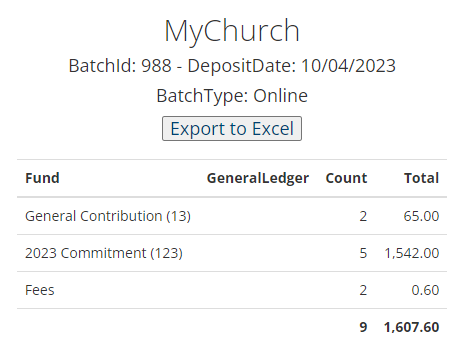Batch Report with Fee Rows¶
Currently there are three standard options for the single batch report and three specialized options. Below is a summary of each:
Batch Report - a legacy report that shows totals for cash and checks, so may be suitable as a deposit report
Batch Report 2 - each batch entry with fund totals
Batch Report 3 - fund totals
Batch Report by Campus - fund totals by Campus
Batch Report with Fee Rows - fund totals by day with rows for fees
Batch Report by Type - fund totals by type (Contribution or Registration)
Note
When configured, the report can be run by clicking the report icon for the desired batch. See image below.
- Batch Report with Fee Rows¶
This report provides the following information for each Batch.
- Header
Church Name
Batch ID #
Deposit Date
Batch Type
- Details
Contribution Date
Fund
General Ledger
Count
Total
In the details, the contributions are grouped by Date and Fund with sub-totals and a grand total at the bottom of the report. The Total give the amount minus any fees, which have their own row.

Report Icon¶

Sample Report¶
Create the Batch Report¶
- Step 1
Go to Admin > Advanced > Special Content > Python Scripts.
- Step 2
Click the green + New Python Script File, enter the file name
BatchReportFand click Submit.- Step 3
Copy all the Python code below and paste it into the new file.
Click Save Python Script.
- Step 4
Go to Admin > Advanced > Special Content > SQL Scripts.
- Step 5
Click the green + New SQL Script File, enter the file name
BatchReportFsqland click Submit.- Step 6
Copy all the SQL code below and paste it into the new file.
Click Save Script.
- Step 7
Find the Setting
Custom Batch Reportat Admin > Advanced > Settings on the Finance tab and in the Batches categoryPaste this as the value -
/PyScript/BatchReportF?p1={bundleid}
Note
Each database can have only one BatchReport. So, the Setting is just named CustomBatchReport and the Value determines which is used.
Generate the Batch Report¶
To generate the report, click the report icon for the desired batch.
Use the print feature of your browser to print the report. Click the Export to Excel button to export.
Python Code¶
1 2 3 4 5 6 7 8 9 10 11 12 13 14 15 16 17 18 19 20 21 22 23 24 25 26 27 28 29 30 31 32 33 34 35 36 37 38 39 40 41 42 43 44 45 46 47 48 49 50 51 52 53 54 55 56 57 58 59 60 61 62 63 64 65 66 67 68 69 70 71 72 73 74 | model.Title = 'Batch Report' sqlheader = ''' SELECT h.BundleHeaderId, CONVERT(varchar(10), h.DepositDate, 101) AS DepositDate, Church = (SELECT Setting FROM dbo.Setting WHERE Id = 'NameOfChurch'), bt.Description FROM dbo.BundleHeader h RIGHT JOIN lookup.BundleHeaderTypes bt ON bt.Id = h.BundleHeaderTypeId WHERE BundleHeaderId = @P1 ''' template = ''' <style> button > a:visited, button > a:hover { text-decoration: none; } @media print { .export {display: none} } table.table.no-border td, table.table.no-border th { border-top: none; } .box p {display: none;} </style> <table class="table notwide centered"> <thead> {{#with header}} <tr> <td colspan="7"> <div class="text-center"> <h2>{{Church}}</h2> <h4>BatchId: {{BundleHeaderId}} - DepositDate: {{DepositDate}}</h4> <h4>BatchType: {{Description}}</h4> <h4 class="export"><button> <a href=/RunScriptExcel/BatchReportFsql/{{BundleHeaderId}} target="_blank">Export to Excel</a> </button></h4> </div <br> </td> </tr> {{/with}} <tr> <th>Fund</th> <th>GeneralLedger</th> <th class="right">Count</th> <th class="right">Total</th> </tr> </thead> <tbody> {{#each gifts}} <tr {{#unless Fund}}style="font-weight:bold"{{/unless}}> <td>{{Fund}}</td> <td>{{GeneralLedger}}</td> <td class="right">{{Count}}</td> <td class="right">{{Fmt Amount 'N2'}}</td> </tr> {{/each}} </tbody> </table> ''' Data.header = q.QuerySqlTop1(sqlheader) sqlgifts = model.Content('BatchReportFsql') params = { 'P1' : Data.p1 } Data.gifts = q.QuerySql(sqlgifts, params) print model.RenderTemplate(template) |
SQL Code¶
1 2 3 4 5 6 7 8 9 10 11 12 13 14 15 16 17 18 19 20 21 22 23 24 25 26 27 28 29 30 31 32 33 34 35 36 37 38 39 40 41 42 43 44 45 46 | DROP TABLE IF EXISTS #base SELECT c.FundId [FundId], CASE WHEN c.ContributionTypeId = 99 THEN isnull(accnt.Description, '') ELSE CONCAT(f.FundName, ' (', CONVERT(VARCHAR(12), c.FundId), ')') END FundName, CASE WHEN c.ContributionTypeId = 99 THEN isnull(accnt.Code, '') ELSE f.FundIncomeAccount END GeneralLedger, c.ContributionAmount - isnull(c.ChargedFee, 0) Amount INTO #base FROM dbo.Contribution c JOIN dbo.ContributionFund f ON f.FundId = c.FundId JOIN dbo.BundleDetail bd ON bd.ContributionId = c.ContributionId LEFT JOIN lookup.AccountCode accnt ON accnt.Id = c.AccountCodeId WHERE bd.BundleHeaderId = @P1 AND isnull(c.PledgeFlag, 0) = 0 AND c.ContributionStatusId = 0 AND c.ContributionTypeId NOT IN (6,7,8) DROP TABLE IF EXISTS #fees SELECT 999999 [FundId], 'Fees' FundName, '' GeneralLedger, c.ChargedFee Amount INTO #fees FROM dbo.Contribution c JOIN dbo.ContributionFund f ON f.FundId = c.FundId JOIN dbo.BundleDetail bd ON bd.ContributionId = c.ContributionId LEFT JOIN lookup.AccountCode accnt ON accnt.Id = c.AccountCodeId WHERE bd.BundleHeaderId = @P1 AND isnull(c.PledgeFlag, 0) = 0 AND c.ContributionStatusId = 0 AND c.ContributionTypeId NOT IN (6,7,8) AND c.ChargedFee > 0 ;WITH data AS ( SELECT * FROM #base UNION ALL SELECT * FROM #fees ) SELECT FundName Fund, GeneralLedger, count(*) Count, sum(Amount) Amount FROM data GROUP BY GROUPING SETS ( (FundId, FundName, GeneralLedger), () ) |
Latest Update |
11/03/2025 |
Updated Save button wording and menu locations
